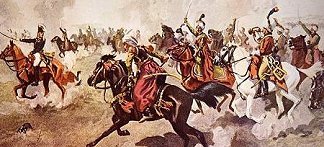In December 1805, brigadier general Jean Rapp led a memorable attack at Austerlitz, when he charged at the head of two squadrons each of the Mounted Chasseurs and the Mounted Grenadiers of the Guard and the Guard Mameluks and decimated the Chevalier Guards of the Russian Imperial Guard.
Within the Grande Armee, the Imperial Guard – the corps d’elite, formally established in 1804 – occupied a special place. Its origins went back to the Guides that had escorted Bonaparte in Italy and Egypt, the Guard of the Directoire and the Consular Guard. At the outset the Imperial Guard numbered 5,000 infantry, 2,000 troopers and 24 guns – about 8,000 in all- but Napoleon constantly added new units, enlarging the Guard into a corps and eventually into an army with its own support services. With many nationalities – Frenchmen, Belgians, Dutchmen, Poles, Mamelukes and others in its ranks – it embodied Napoleon’s ambitions and was evidence of his continental empire. By 1805 its strength had risen to over 12,000 and in 1812 it numbered 56,000. Thereafter, its character became much diluted so that the 1814 figure of 112,482 men no longer represented only elite units.
Two varieties of light cavalry involved in the Napoleonic Wars were unlike the general type, and involved particular tactical abilities. One of the most distinctive, albeit prominent in only one theatre of war, was the Mamelukes encountered by Napoleon’s expedition to Egypt (1798-1801). Recruited from Caucasians, these warriors had been resident in Egypt from the 13th century; originally intended as a military elite in the service of the reigning sultan, they usurped his power and took over the land, retaining much of their authority even after the Turkish conquest of 1517. Replenished by a constant supply of boys from the Caucasus, they formed a warrior caste that dominated the native inhabitants and produced a force of around 10,000 light cavalry.
Equipped in an almost medieval fashion, sometimes including a mail coat and iron helmet, the individual Mameluke was an expert horseman and swordsman and a most formidable opponent. Armed with curved sabres of high quality, they could out-fence most conventional cavalry, and some remarkable feats were recorded – at the battle of the Pyramids in July 1798 one kyacheff (provincial governor or senior commander) was said to have actually sliced through muskets. Their armament also included carbines (often of bell-mouth design), pistols, and light javelins (a weapon sometimes styled a ‘jereed’), and each Mameluke was accompanied by two or more dismounted servants or serradj.
Though individually so formidable, the Mameluke had no more sophisticated tactic than a headlong charge of almost suicidal bravery, firing his carbine and several pairs of pistols, then throwing his javelins before closing with the sabre; the serradj followed to retrieve their masters’ firearms, dropped after discharge, and to dispatch any surviving enemy. Heroism and skill-at-arms could not overcome disciplined formations, however, and when sent against Napoleon’s infantry formed in square the Mameluke charges foundered at terrible cost.
In 1798 the West clashed with the Mamelukes when Napoleon invaded Egypt. Their élan and bravery was of an age long gone. The Mamelukes were no match for the veterans of Bonaparte’s army. After Napoleon returned to France, General Menou formed a Mameluke detachment which soon became part of Bonaparte’s personal guard. Their loyalty was never questioned and they, fatally for some, became synonymous with Napoleon and his empire. His final fall led to many Mamelukes in France being murdered by vengeful Royalists. Throughout the long wars the Mamelukes serve with the Imperial Guard’s Chasseurs à Cheval.
This small Mameluke element was retained throughout Napolon’s reign; they continued to use traditional costume and weapons, and provided perhaps the most exotically colourful unit in his army. Latterly, however, it was impossible to replace losses among the ‘genuine’ Mamelukes (Caucasians, North Africans and Levantines), so Frenchmen were admitted to their ranks.
Mameluke scimitar
The campaigns in Egypt prompted the adoption of the oriental or ‘mameluke’ sabre, a sharply-curved weapon with guardless hilt. Highly-fashionable, particularly amongst light cavalry officers, the pattern was carried unofficially, becoming so popular that European copies of oriental weapons were produced; they were also favoured by musicians and particularly by drum-majors. Other ‘native’ weapons included the Caucasian knife/sabre used by Russia’s Asiatic irregular cavalry, the ‘kindjal’ being a double-edged, slightly-curved and guardless short sword; longer-bladed versions were used though the regulation Cossack ‘shashqa’ was not issued until 1834. The mamelukes of the French Imperial Guard carried not only Turkish scimitars but even a Turkish dagger in brass sheath.
The bell-mouthed ‘blunderbuss’ (a derivation of the Dutch/German ‘thunder-gun’), popularly thought to fire a mixture of nails and scrap-iron, was little-used as an ‘issue’ weapon. Austria had issued the ‘trombone’ or blunderbuss to cuirassiers in 176o, firing a charge of twelve small balls, and ‘Austrian Blunderbusses’ was the description given to the hundred ‘musketoons’ issued to the ‘flankers’ of the British 23rd Light Dragoons in 1781. Between 1801 and 1813, seventy-three blunderbusses were supplied by the Versailles factory to the mamelukes of the French Imperial Guard, but despite wider use for ‘sea service’ the blunderbuss was only otherwise used by the Spanish guerrillas, with whom it did use peculiar ammunition: Marbot was hit by a jimped-edged flat lead bullet about the size of a half-crown, calculated to cause frightful injury.
